There are so many cool ways to create mandala art! Think bold black-and-white patterns swirling with tiny details, dreamy watercolors blending together like magic, or even mandalas made from leaves, seeds, and pebbles. Some artists use gold leaf for fancy shimmer, while others team up for huge community projects, splashing colors everywhere. You can draw freehand, use recycled scraps, or turn your design into wall art that wows. If you want creative sparks to fly, stick around—these ideas just get better!
Key Takeaways
- Explore mandala art forms like watercolor, black and white, zen doodle, and mixed media for diverse creative inspiration.
- Experiment with mandalas using recycled or natural materials to create eco-friendly and nature-inspired designs.
- Personalize mini mandala projects such as artist trading cards and bookmarks for meaningful, small-scale masterpieces.
- Incorporate bold color schemes or calming palettes to influence mood and visual impact in your mandala artwork.
- Collaborate on community mandala projects or use templates to discover new patterns and develop your own unique style.
Classic Black and White Mandala Patterns
Even though mandalas can burst with color, there’s something seriously cool about classic black and white mandala patterns.
When it comes to art, black and white designs let the details shine, showing off every twist, turn, and sharp line.
With mandala art, it’s all about the symmetry—that neat, repeating magic you get from drawing careful lines and shapes.
Beginners love these patterns because they’re great for practicing, and if you mess up, hey, no one needs to know.
Artists can use black and white mandalas as templates, filling them in with their own wild ideas or even a pop of color later.
Plus, working on these can be super relaxing, like doodling with purpose.
It’s art therapy, but way cooler.
Botanical Motif Mandala Designs
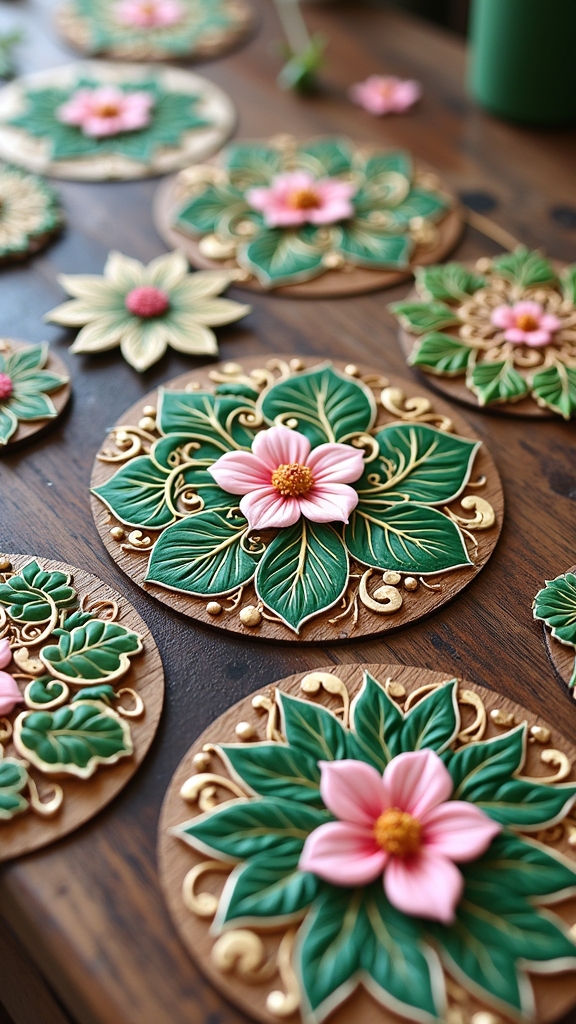
Botanical motif mandala designs bring in the beauty of leaves, flowers, and vines, turning nature’s shapes into stunning patterns.
Artists often start with black and white sketches, paying close attention to how each petal or stem can fit into a repeating design, and sometimes they even get creative with color later on.
It’s a bit like making your own secret garden—one that fits perfectly inside a circle and looks awesome whether you stick to line work or go wild with paint.
Essential Botanical Motif Elements
Leaves, petals, and twisting vines—these are just a few of the essential elements that can turn a simple mandala into a blooming work of art.
For anyone working on an art project, botanical motif mandalas are great fun because they let you play with nature’s shapes and colors. Even though it might seem tricky at first, all you really need is a few sketches of your favorite leaves or flowers to get started.
Mix in some swirling vines or pointy petals, and suddenly, your mandala looks alive! Try photocopying at least four different motifs to experiment.
Whether you use black ink for crisp lines or bright watercolors for a splashy effect, botanical motifs add calm and creativity, making the process relaxing and rewarding.
Integrating Nature in Mandalas
There’s nothing quite like mixing the wonders of nature into a mandala, especially when it means filling those circular designs with the shapes of real leaves, flowers, and seeds.
Creating botanical motif mandalas is like going on a little adventure—gathering treasures from the backyard, then using them to spark a whole world of creativity.
Let’s be honest, it’s hard not to feel a bit like a nature wizard when you’re arranging petals into hypnotic patterns.
These nature-inspired mandalas offer something special:
- Nature healing: Each design brings a sense of calm and mindfulness.
- Mandala symbolism: Flowers and leaves symbolize growth, renewal, and life’s cycles.
- Botanical exploration: Planning with real plants helps artists discover new shapes, colors, and ideas.
It’s art that truly grows on you!
Black and White Techniques
While some artists love to splash their mandalas with color, there’s something oddly magical about sticking to just black and white when drawing nature-inspired designs.
Black and white contrast makes every leaf, petal, and vine pop, turning even the simplest doodle into a showstopper. Botanical motif mandalas invite artists to engage in organic shapes exploration—think twisting stems, spiraling flowers, or funky seed pods.
Pattern repetition techniques are key here; repeating shapes and lines creates mesmerizing designs that seem to move right off the page. It’s like nature’s own hypnotic dance, but in ink!
Plus, working in black and white isn’t just for pros. Beginners find it easier to master form and detail, and there are tons of worksheets online to help anyone start.
Nature-Inspired Mandalas Using Found Objects
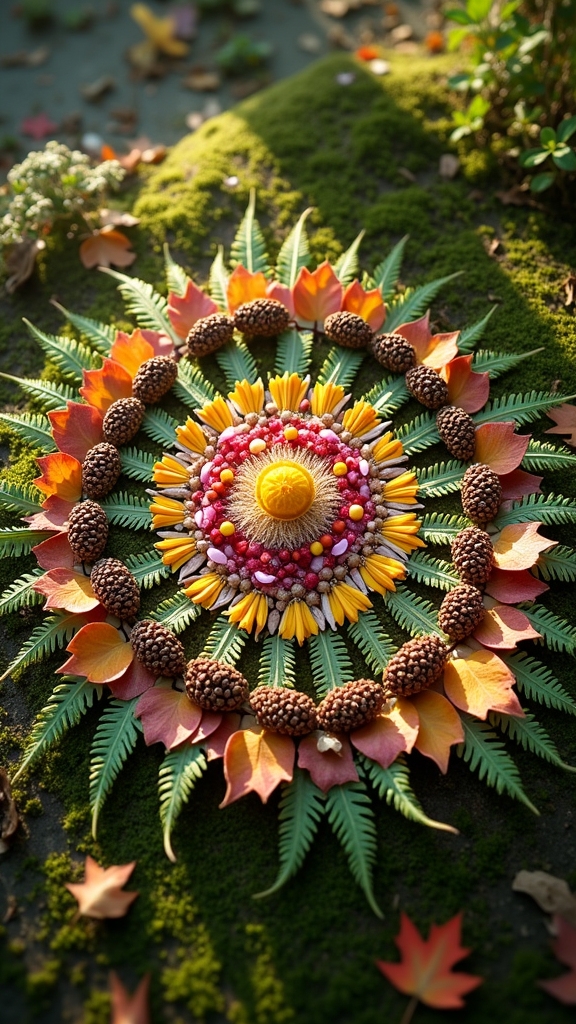
A handful of creative artists have discovered that some of the best mandalas aren’t made with pencils or paint—they’re built from the wild treasures found right outside.
Nature mandala techniques use leaves, petals, stones, and bark, all arranged into beautiful, repeating patterns on the ground. Inspired by seasonal mandala inspirations, artists often gather vibrant materials that reflect the colors of spring blooms or fallen autumn leaves.
Mindful mandala practices turn the process into a peaceful break, where each piece is placed with care and attention. Sometimes, the magic of these artworks is that they don’t last—wind or rain might carry them away.
But before they vanish, they evoke feelings like:
- Wonder at nature’s colors
- Joy from creative play
- Calm from mindful arranging
Watercolor Mandala Creations
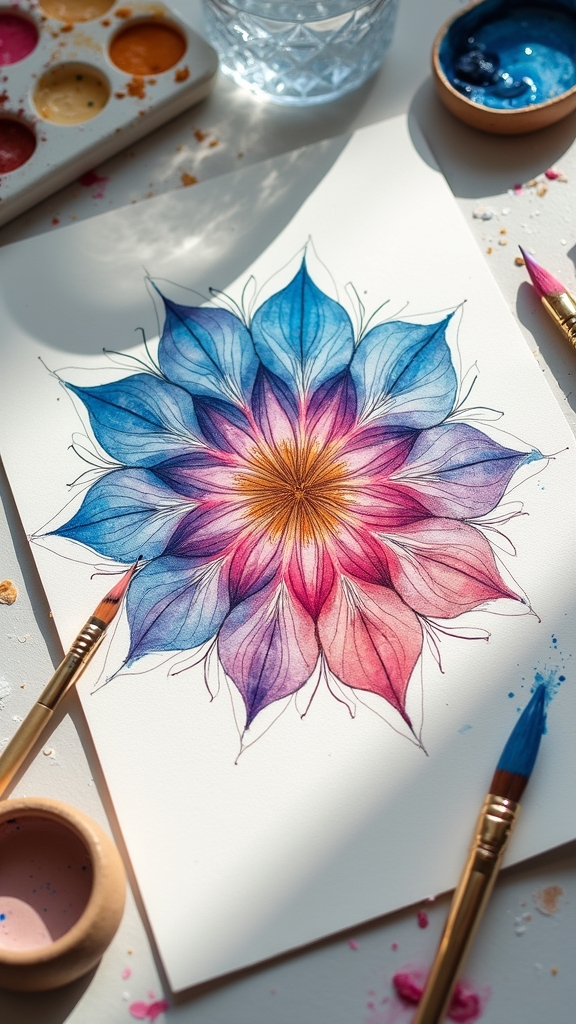
Watercolor mandalas burst onto the scene with splashes of color that can look as dreamy as a cloud at sunset. Artists use watercolor techniques to make these mandalas come alive, layering washes and blending colors so they flow into each other like magic.
Sometimes, black and white outlines are drawn first, almost like a coloring book, and then filled in with gentle, flowing paint. This helps add depth and makes the colors pop! The coolest part? Watching the colors bleed together is just so relaxing, it’s like the paint does half the work for you.
Working on high-quality watercolor paper prevents warping and keeps those colors bright. If you’re hunting for mandala inspiration, watercolor creations are a mesmerizing place to start.
Mandala Art With Seeds and Natural Materials
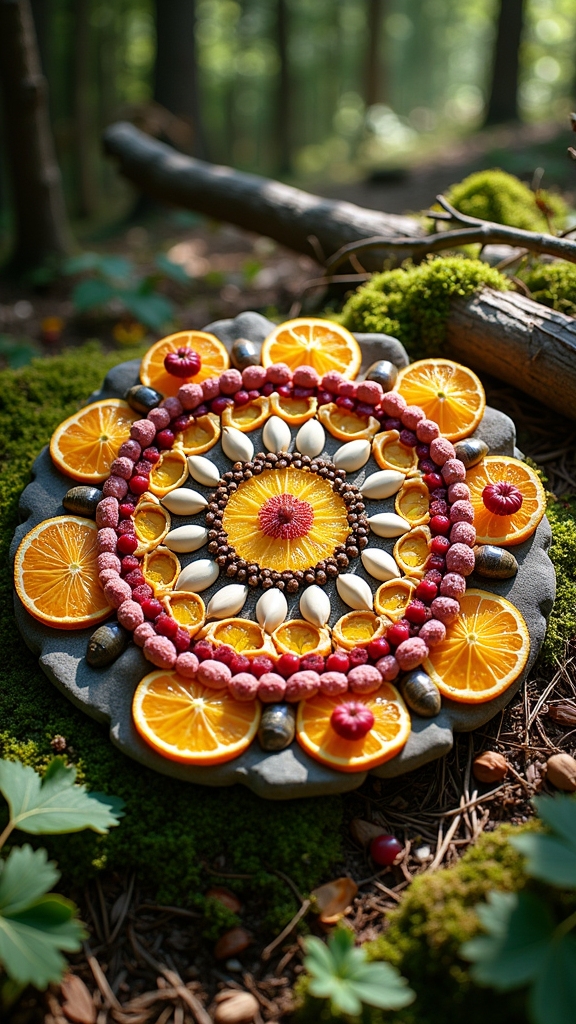
Nature’s toolbox can turn any mandala project into a wild adventure. Imagine grabbing a handful of acorns or flower petals, and suddenly, you’re an artist with materials straight from the earth.
Using seed collection techniques, students discover colors, shapes, and even a few creepy-crawlies along the way. Organic design inspiration strikes as every seed and petal finds its place in the circle—no two mandalas are ever the same.
The real magic? Natural texture exploration. Touching all those bumpy, smooth, and fuzzy pieces makes every design come alive!
Here’s why you’ll fall in love:
- Gathered seeds add personality to every pattern.
- Textures and colors pop against watercolor paper backgrounds.
- The temporary nature of these mandalas makes every moment unforgettable.
Geometric Mandala Artworks
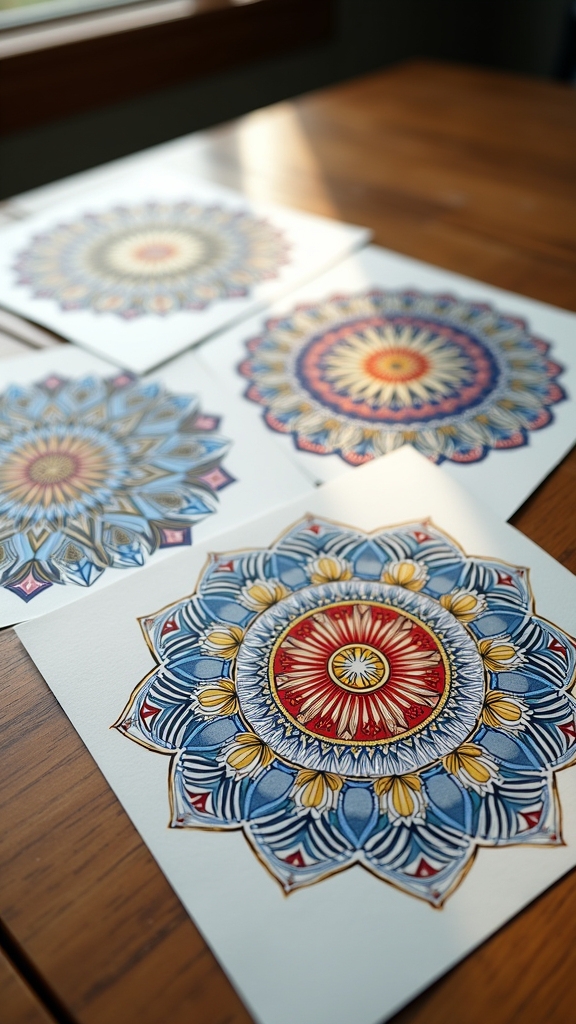
Everywhere you look in geometric mandala artworks, there’s a wild world of shapes and symmetry just waiting to pull you in. Circles, triangles, and squares seem to dance, repeating themselves in a hypnotic rhythm that begs for a closer look.
Geometric symmetry exploration is like a secret code—one wrong move and the whole pattern wobbles, but get it right and it’s pure magic. With a splash of color theory application, artists make these mandalas pop, using bold shades and clever line thickness to add depth and excitement.
But wait—there’s more! Mathematical patterns analysis comes into play, with things like the Golden Ratio sneaking in to bring perfect balance.
Whether drawn by hand or made digitally, geometric mandalas always impress.
Zen Doodle Mandala Patterns
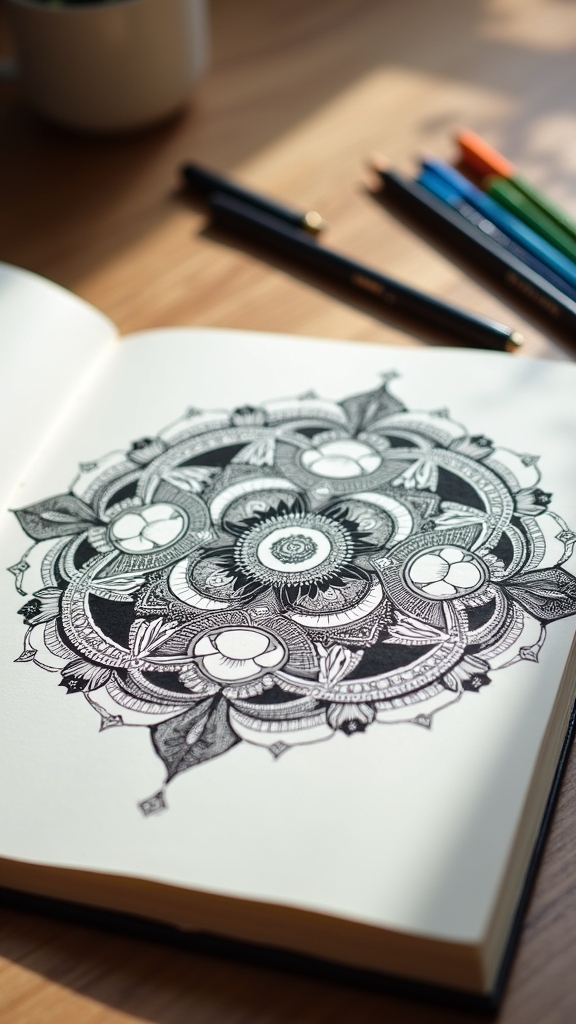
Zen doodle mandala patterns are all about using simple, repetitive techniques, like drawing loops, swirls, and zigzags, to build up awesome designs that feel relaxing to make.
Artists love mixing and matching different patterns inside the mandala’s sections, sometimes creating wild combinations that look almost magical.
Ready for a little organized chaos? Let’s check out the essential tricks and see how patterns come together in these creative works.
Essential Zen Doodle Techniques
Some of the coolest mandalas out there are actually made using simple Zen Doodle techniques—seriously, you don’t need to be a pro artist to get started!
Zen Doodle mandalas use basic shapes like dots, lines, spirals, and florals, making it easy for anyone to jump in. The real magic happens when doodle mindfulness practices kick in and you start noticing how repetitive pattern benefits calm your mind.
Even in black and white, these mandalas pop with contrast and clarity, letting your creativity shine without worrying about color choices.
If you want to explore zen creativity, try these techniques:
- Focus on slow, repetitive lines to relax your mind.
- Mix and match simple shapes for unique patterns.
- Let mistakes become part of your creative journey!
Combining Patterns for Mandalas
Even though making a mandala might sound complicated, combining patterns is actually where things get really fun—think of it like remixing your favorite doodles into one awesome design!
With Zen doodle mandala patterns, artists can explore pattern layering techniques by stacking shapes like circles, spirals, and lines. This isn’t just about piling stuff on; it’s about creating cool depth and eye-popping visuals.
Mandala symmetry exploration lets you repeat these unique pattern combinations in a way that’s both harmonious and totally mesmerizing. Some people even say it feels relaxing, almost like a brain massage!
Mixing black and white patterns can make the mandala pop, balancing simplicity with wild complexity. Worksheets and templates help beginners join the fun, making mandala magic super accessible.
Triangular Pattern Mandalas
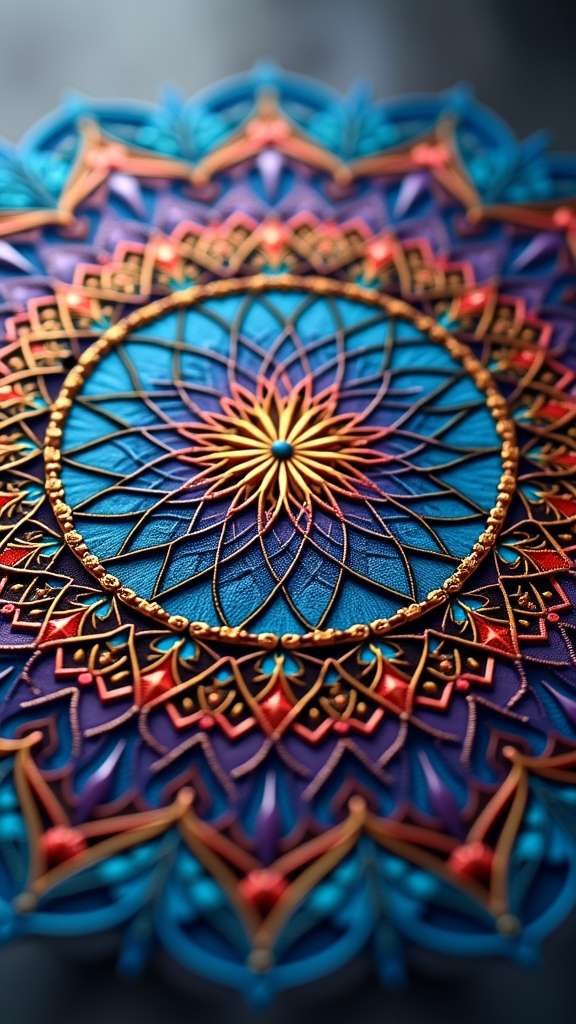
When artists want to step up their mandala game, triangular pattern mandalas are where things get seriously interesting. These designs use triangular symmetry and pattern repetition to create artwork that almost jumps off the page with artistic depth.
With over 140 different triangular patterns out there, artists have a playground for their creativity—seriously, it’s hard not to get excited! Even beginners can get started, using simple lines and dots to make triangles pop. Zentangle resources add extra flair, letting artists experiment with textures and details for even more wow-factor.
Here’s why triangular pattern mandalas are totally inspiring:
- They deliver mind-blowing complexity with simple shapes.
- Repetition of triangles creates a hypnotic effect you can’t ignore.
- Layered patterns add wild, unexpected artistic depth.
Try them—your sketchbook will thank you!
Mandala Art for Bookmarks
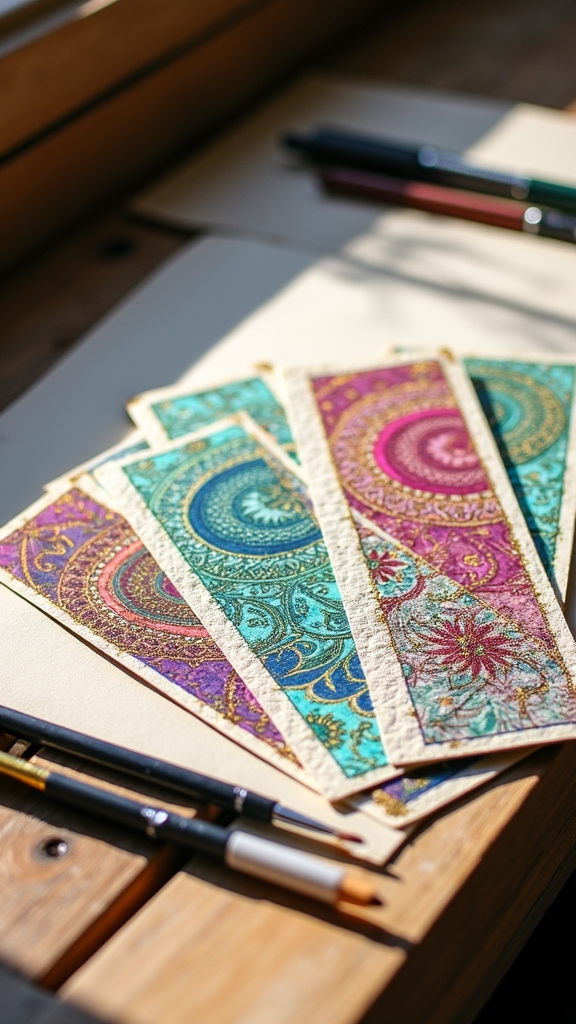
Mandala art isn’t just for big canvases—some of the coolest designs end up on bookmarks, making every chapter feel a little more magical.
Artists can play around with creative ideas, like filling the bookmark with bold black and white patterns or sneaking in a favorite quote right in the middle of all those swirls.
Mixing up different techniques, such as using fine-tip pens for details or coloring in some parts, can turn a simple strip of paper into the kind of bookmark you’ll actually want to show off.
Creative Bookmark Design Ideas
A bunch of creative ideas can turn a simple bookmark into a tiny masterpiece, especially when mandala art gets involved. Mandalas aren’t just pretty patterns—they’re a whole vibe for anyone wanting their next read to feel extra special.
Bookmark personalization techniques make it easy to show off your style, whether you pick swirling black-and-white lines or doodle in bold colors. And let’s not forget mandala coloring activities; they’re a blast for both kids and adults, perfect for a chill afternoon or a fun group hangout.
Here are three reasons to amp up your bookmark game with mandalas:
- Personalized bookmarks make creative gifting ideas that wow friends.
- Coloring mandalas can calm your mind and bring joy.
- Inspirational quotes inside mandalas spark positivity every time you read!
Techniques for Mandala Patterns
Immerse yourself in the world of mandala patterns, and suddenly bookmarks go from “meh” to mesmerizing.
Mandala pattern exploration starts with drawing simple shapes—circles, petals, triangles—and then layering on details using bold black and white lines for that eye-popping contrast.
Want to kick things up a notch? Plunge into color theory application with watercolor, ink, or gouache, and watch your bookmarks burst with personality.
Symmetry techniques are a must for mandalas—think repeating shapes, mirrored motifs, and a sense of balance that just feels right.
Switch things up by adding botanical or geometric designs (hello, the “Motif Play” PDF!), so every bookmark is a one-of-a-kind masterpiece.
In the end, your creative experiments make every page you mark a tiny work of art.
Mandalas on Canvas With Acrylics
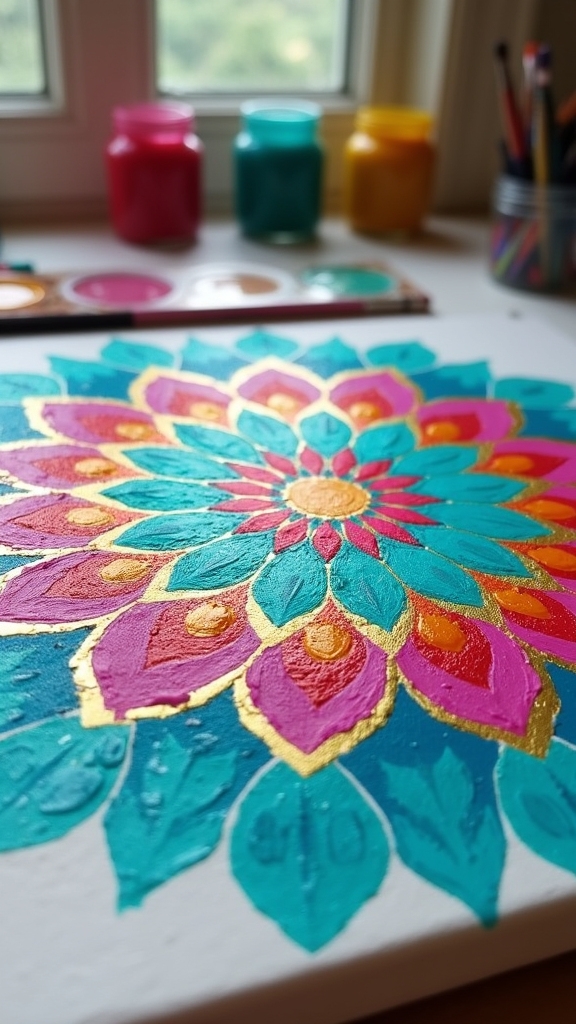
When artists pick up their acrylic paints and a blank canvas, it’s like jumping into a world where colors practically shout for attention. Creating mandalas on canvas with acrylics is all about bold choices, wild imagination, and a few sneaky tricks.
First comes the magic of canvas preparation—some artists slap on a wild base color just to make everything pop. Then, using different acrylic techniques, they layer, blend, and swirl colors until each circle and petal feels electric.
And don’t forget the details; tiny brushes help make those lines crisp and sharp.
Here’s what really gets the heart racing:
- The thrill of color blending that turns simple paint into pure magic.
- The satisfaction as patterns emerge from the chaos.
- That final, shiny coat—sealing in all the beauty!
Mandala Drawings for Beginners
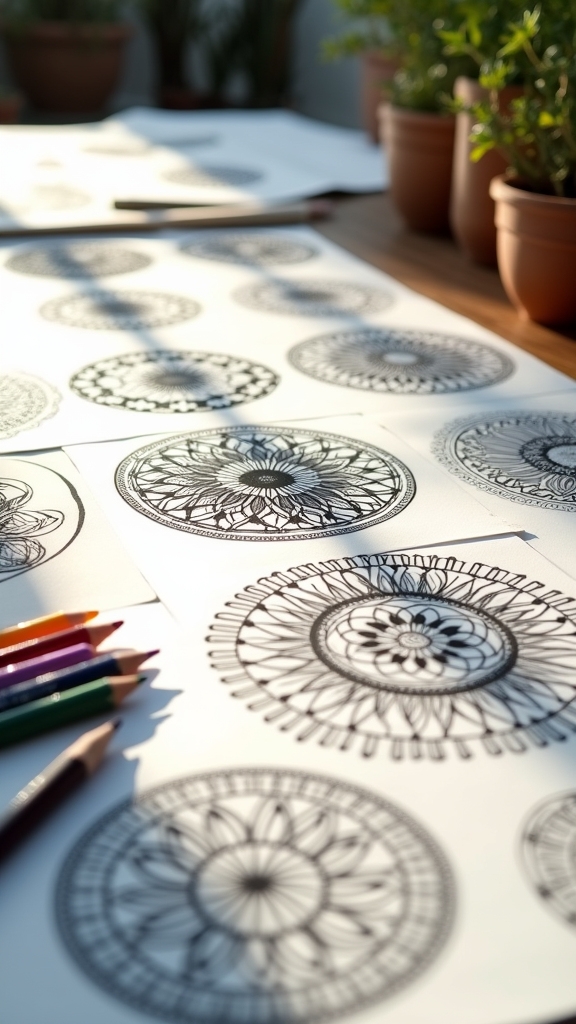
Not everyone wants to haul out a pile of paint tubes and get their hands messy—sometimes, all it takes is a pencil, a piece of paper, and a spark of curiosity to get started with mandala art.
For beginners, there are 24 simple mandala designs out there, each with step-by-step instructions, so no one has to panic about beginner mistakes. Worksheets with basic shapes and patterns help newbies practice, and focusing on black and white designs keeps things simple.
Drawing meditation is a big part of the process—it’s not just doodling, it’s relaxing! Mandala symbolism sneaks in, too, teaching about balance and unity.
Zen doodle patterns make it fun, so confidence grows fast. Honestly, anyone can give it a try!
Mandala Art Therapy Pieces

Plenty of people find that making mandala art isn’t just about drawing pretty shapes—it can actually help you feel better, too.
Mandala art therapy pieces are more than colorful circles; they’re tools for emotional release and self-discovery. When someone sits down to play with mandala symbolism exploration, patterns and colors become a secret language for feelings that are hard to say out loud.
In fact, mandala community workshops often bring people together, helping them connect and heal as a group.
Here are three powerful reasons why mandala art therapy pieces can really touch your heart:
- They help you let go of stress through creative emotional release techniques.
- They bring calmness and clarity by focusing your mind.
- They encourage personal growth and happiness by expressing your inner world.
Mandala Art Using Colored Pencils
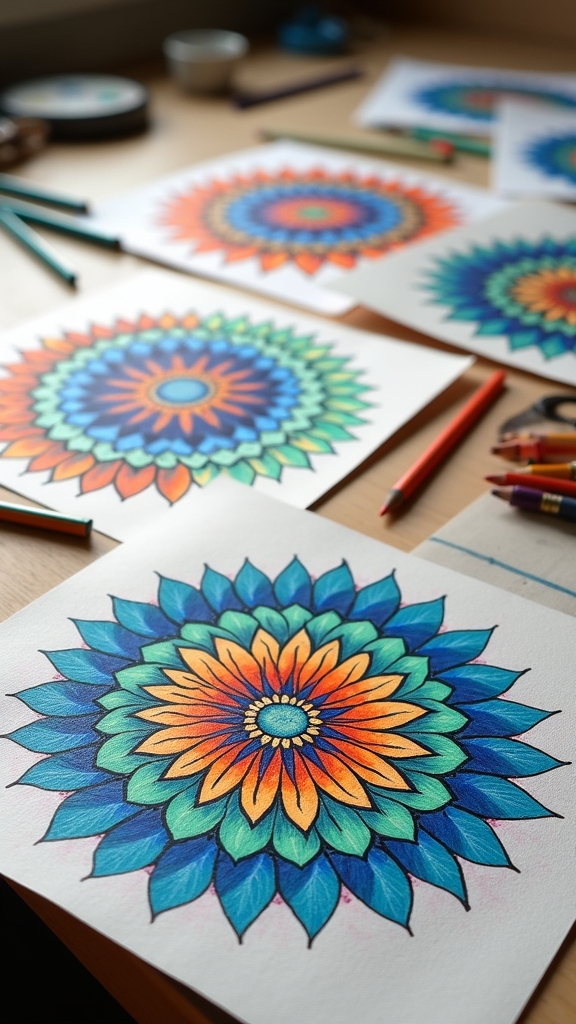
After exploring how mandala art therapy pieces can work wonders for the mind and heart, it’s time to get hands-on with a medium that’s both colorful and forgiving—colored pencils. Mandala art using colored pencils lets artists immerse themselves in intricate patterns with total control. Want super-smooth mandala color blending or bold pops of color? Colored pencil techniques make it possible. Plus, artistic layering methods let you build up shades, add shadows, and even fix mistakes if you color outside the lines (hey, it happens). The best part? Watching vibrant designs come alive, one layer at a time, feels almost magical.
| Technique | Why It Rocks For Mandalas |
|---|---|
| Layering | Builds depth and rich color |
| Blending | Smooth shifts, no harsh lines |
| Detailing | Sharp points for tiny patterns |
| Erasing/Correcting | Easy fixes, less stress |
Mandalas Featuring Inspirational Quotes
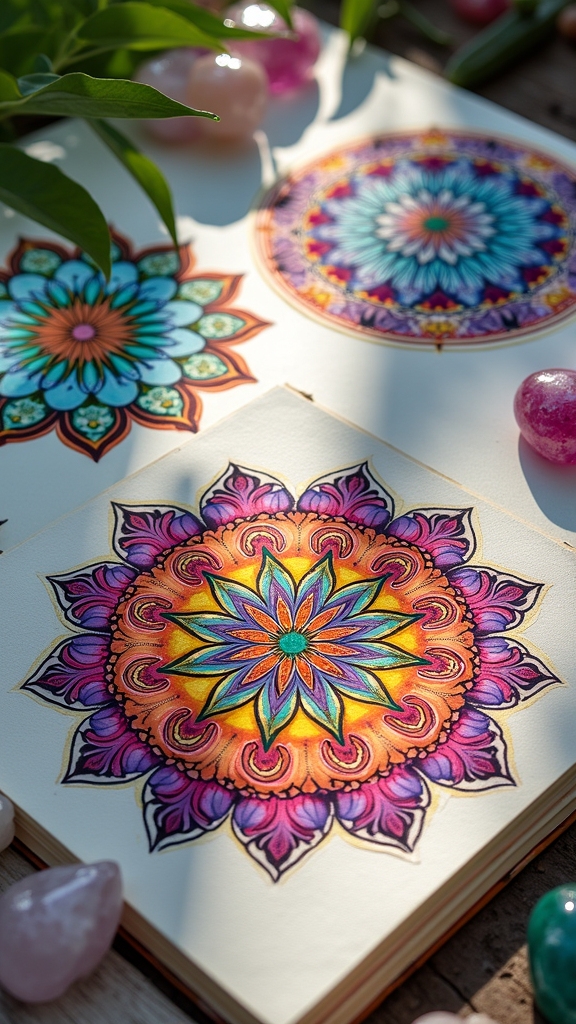
Mandalas featuring inspirational quotes pack a double punch—they look amazing and give your mood a boost at the same time.
The words pop even more when artists use bright, bold color schemes that seem to cheer you on just by hanging on your wall.
It’s like your own personal pep talk, wrapped up in a swirl of awesome shapes and colors.
Motivational Messages in Mandalas
Inspiration can be a powerful force, especially when it’s woven right into art. Mandalas featuring motivational messages are more than just pretty patterns—they’re like secret cheerleaders on your wall. Each design often wraps around positive affirmations or uplifting quotes, making you stop and think about what really matters.
The process isn’t just about coloring between the lines, either. It’s a chance for creative expression and a moment for personal reflection. Here’s why these mandalas pack such an emotional punch:
- They remind you of your inner strength when you’re feeling low.
- The combination of art and words sparks positive energy, even on tough days.
- Creating or viewing them encourages self-discovery, helping you grow and shine brighter.
Color Schemes for Inspiration
Color can totally change the mood of a room, and when it’s paired with a powerful quote inside a mandala, it’s like giving your walls a pep talk.
Artists use color psychology to pick shades that match the message—think cool blues and greens for calm, or bold reds and yellows for energy. These color schemes aren’t just about looking pretty; they’re chosen for their emotional resonance and color symbolism, making you feel inspired or relaxed just by glancing at them.
The high-res printing makes the colors pop, turning any wall into a vibe booster. Mandalas with inspirational quotes and thoughtful color palettes help counter negativity, spark creativity, and create a space where it’s easier to focus, reflect, or just feel good.
Symmetrical Kaleidoscope Mandala Prints
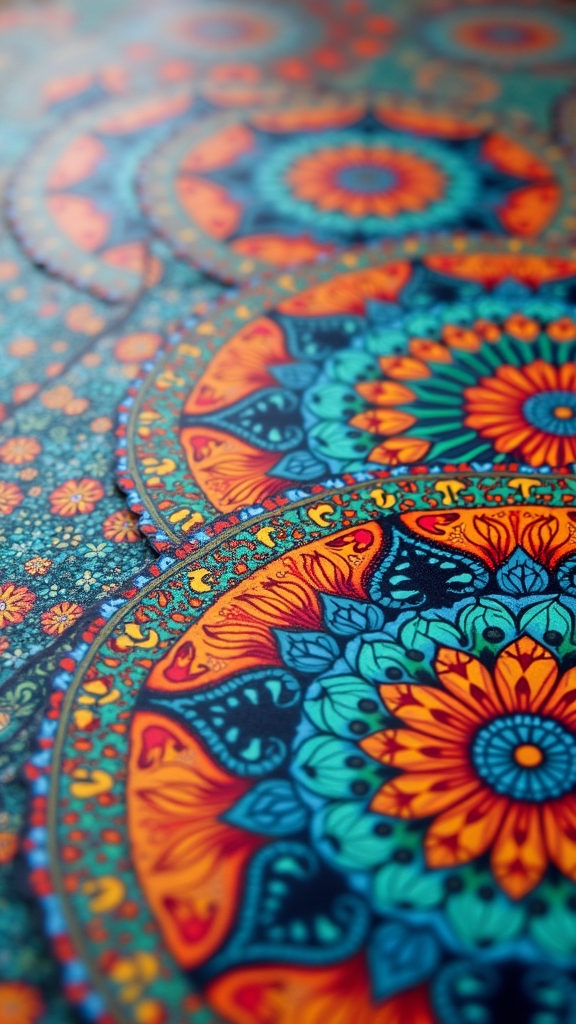
Patterns that swirl and twist with perfect balance—symmetrical kaleidoscope mandala prints are like tiny universes trapped on a page. Each one grabs your attention, pulling you in with wild colors and repeating shapes.
Thanks to kaleidoscope color theory, artists blend vibrant hues, making every print seem alive. Symmetrical design techniques give these mandalas that hypnotic, mirror-like effect, while mandala symmetry exploration lets artists play with both geometric lines and soft, flowy curves.
It’s impossible not to get lost in all the details.
Here’s why these prints are hard to forget:
- Their symmetry feels soothing, almost like a visual hug.
- Bursts of color and texture make every glance exciting.
- Creating or admiring them can spark curiosity and wonder.
Mandalas Created With Recycled Materials

Mandalas made from recycled stuff are a total game changer—they turn old paper, plastic, and even bottle caps into one-of-a-kind masterpieces while helping the planet.
Artists love experimenting with creative upcycling techniques, layering scraps and odd bits to form incredible patterns that look cool and keep waste out of landfills.
Anyone can join in, turning trash into treasure and proving that eco-friendly mandala projects can be both fun and seriously inspiring.
Creative Upcycling Techniques
Even though an empty cereal box or a pile of old magazines might look like trash to most people, some artists see them as the perfect starting point for something amazing—like a mandala made from recycled treasures.
Using creative upcycling techniques, artists cut, tear, and arrange things like cardboard, plastic bottle caps, or fabric scraps into intricate patterns that burst with color and texture.
This approach isn’t just about making cool art—it’s about upcycling benefits, sustainable practices, and bold artistic innovation all rolled into one.
Imagine the excitement of giving new life to something headed for the landfill!
Here are three reasons upcycled mandalas spark such strong feelings:
- They turn waste into wonder.
- They inspire environmental pride.
- They celebrate creative freedom.
Eco-Friendly Mandala Projects
If you’ve ever looked at a pile of old newspapers, bottle caps, or fallen leaves and thought, “That’s just trash,” think again—because eco-friendly mandala projects are all about seeing hidden potential where others see garbage.
These projects turn ordinary waste into extraordinary art by using sustainable materials like recycled paper, plastic, or even natural items. Picture a mandala made from magazine clippings, or one arranged from leaves and stones—each tells a unique story about creative recycling.
Mandala workshops often encourage artists to experiment with discarded packaging, cardboard, and colorful bottle caps, exploring new textures and color combos. Not only do these creations look awesome, but they also shout out for environmental conservation, proving art can spark real change—one recycled mandala at a time.
Inspiring Recycled Material Ideas
Stacks of cardboard, bins full of bottle caps, and heaps of old magazines might seem like a mess waiting for the recycling truck, but to creative minds, they’re a treasure trove just begging to be turned into something amazing.
Mandalas made from recycled paper, plastic lids, or even random buttons explode with color and personality. Each piece brings its own unique textures, making every creation one-of-a-kind. Plus, there’s something seriously cool about turning “trash” into art!
Here’s why making mandalas with recycled materials is so inspiring:
- It sparks sustainable creativity, proving that art can help the planet.
- Every project tells a story, full of memories and surprises.
- Artists discover beauty in the unexpected, transforming scraps into stunning masterpieces.
Mandala Journaling Pages
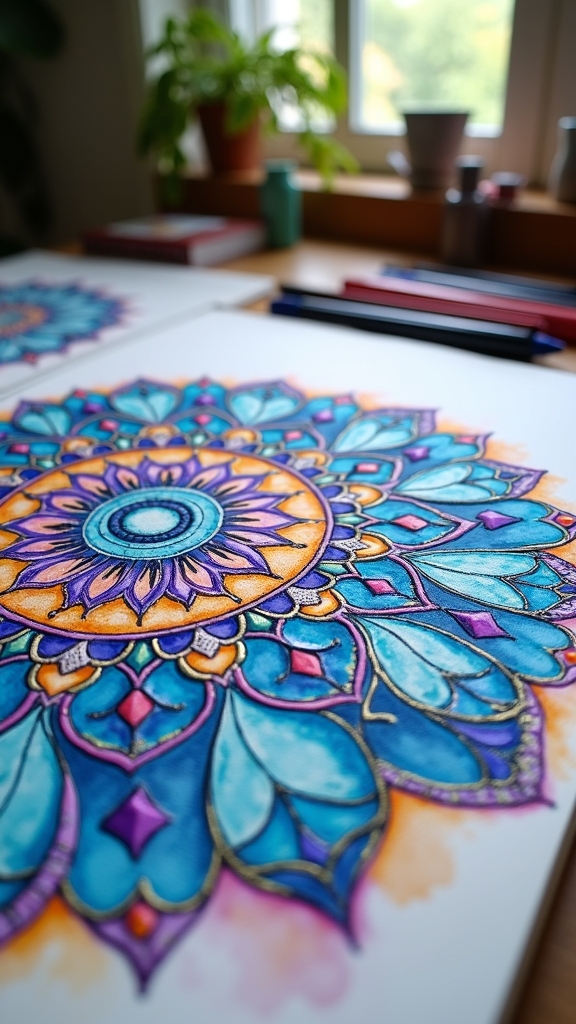
A blank mandala journaling page is like an open invitation to get creative, let loose, and maybe even surprise yourself.
Imagine opening your journal and seeing swirling lines and shapes just waiting for your touch. Mandala journaling pages are all about mindful expression—they help you focus and relax as you fill in personalized designs with your favorite colors and doodles.
Some pages toss in prompts or questions, which is perfect for emotional exploration, helping you figure out what’s going on inside your head without even realizing it. You don’t have to be an art genius, either; just adding your own patterns or thoughts makes the page totally yours.
It’s art therapy, but with bonus points for fun and creativity.
Mandala Art for Artist Trading Cards
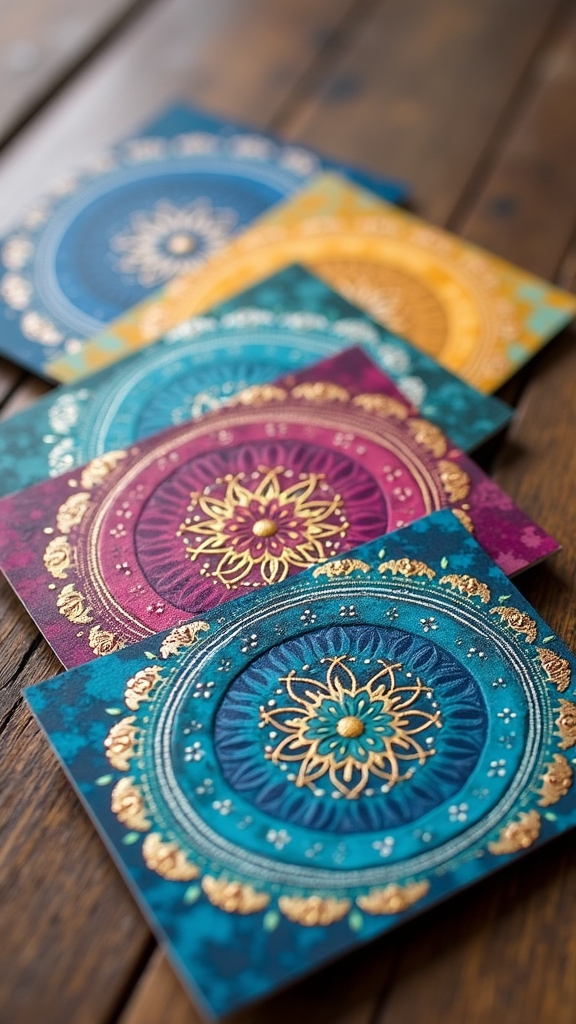
Though they may look tiny at just 2.5 by 3.5 inches, artist trading cards (ATCs) become something truly special when artists fill them with mandala designs.
These bite-sized canvases challenge creators to pack emotion, detail, and meaning into a small space. Artists plunge into mandala symbolism meanings, picking shapes and lines that tell a personal story, while also using mandala design principles like balance and repetition to keep things visually stunning.
Choosing colors isn’t just about looking cool—mandala color psychology helps artists set a mood or send a message.
Here are three reasons why mandala ATCs spark so much excitement:
- They turn every tiny card into a canvas for imagination.
- Sharing and swapping spreads joy and inspiration.
- Each card becomes a miniature, meaningful masterpiece.
Digital Mandala Illustrations
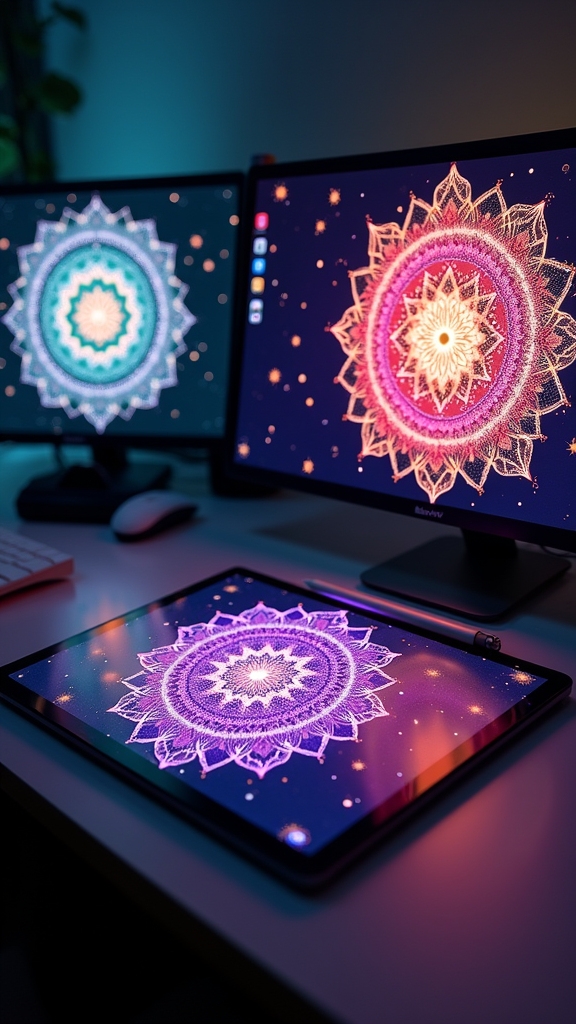
Mini masterpieces on artist trading cards are cool, but digital mandala illustrations take things to a whole new galaxy of creativity.
With digital mandala techniques, artists can make insanely detailed designs that look like they took forever—except, thanks to digital art tools, they didn’t! Mandala design software offers super precise symmetry, which means every petal and swirl lines up perfectly.
Want to try a new color or pattern? Just click and experiment. Duplicating sections is a breeze, so artists can put together wild, complex patterns without breaking a sweat.
Layers let creators add crazy textures and glowing effects that aren’t possible on paper. Plus, digital mandalas can be printed any size or posted online, and they always look sharp.
Digital really is magic!
Mandala Wall Art for Home Decor

Mandala wall art can totally change the vibe of any room, whether you’re going for a chill bedroom, a bold living room, or even a funky hallway.
Bright colors or simple black and white designs both make a big impact, and there’s something oddly satisfying about choosing the perfect look.
For anyone feeling crafty, making your own mandala art can be a fun project—plus, who wouldn’t want bragging rights for decorating their space with something unique?
Styles for Every Room
If someone wants to give their home a serious style upgrade, mandala wall art is a total game changer. With so many mandala design techniques out there, anyone can find a piece that fits their vibe.
Some people go for bold, geometric mandala patterns, while others love the delicate charms of hand-drawn lines. The beauty of mandala color theory is its power to set the mood—soft blues can soothe, while fiery reds bring energy. Each mandala carries unique symbolism meanings, letting personalities shine in every room.
Here’s why mandalas totally transform home spaces:
- They create a calming, mindful atmosphere.
- They let people show off their creativity and style.
- They can inspire joy, peace, or even a sense of adventure.
Color Schemes and Impact
Colors have a sneaky way of changing the whole vibe of a room, and in mandala wall art, they’re basically the stars of the show. Thanks to color psychology, every shade packs some serious emotional resonance.
Warm colors—think rich reds or zesty oranges—bring energy and make mandalas pop in living rooms or kitchens. Cool colors, like chill blues and calming greens, are perfect for bedrooms or meditation corners, helping everyone relax after a long day.
Want to really wow your guests? Try vibrant contrasts—like purple and yellow—so the design practically leaps off the wall. Gradients and ombre effects add depth, while metallic or iridescent paints create a magical shimmer that shifts as you move.
Mandalas aren’t just pretty—they’re mood-changers!
DIY Mandala Art Ideas
Ever wondered how a blank wall could suddenly become the coolest spot in the house? Immerse yourself in DIY mandala art ideas that spark creativity and make your space pop.
With diy mandala kits and a handful of mandala art supplies, anyone can turn plain walls into eye-catching masterpieces. Mandala art workshops and online classes offer tips and tricks, so no one gets stuck staring at an empty canvas.
For those needing inspiration, there are 24 beginner-friendly mandala designs, plus the free “Motif Play” PDF packed with botanical motifs and frameworks.
Here’s how anyone can get started:
- Experiment with watercolor, ink, or gouache techniques.
- Try out designs from diy mandala kits or mandala art workshops.
- Incorporate mindfulness using mandala art therapy resources.
Let creativity run wild!
Freehand Mandala Sketches
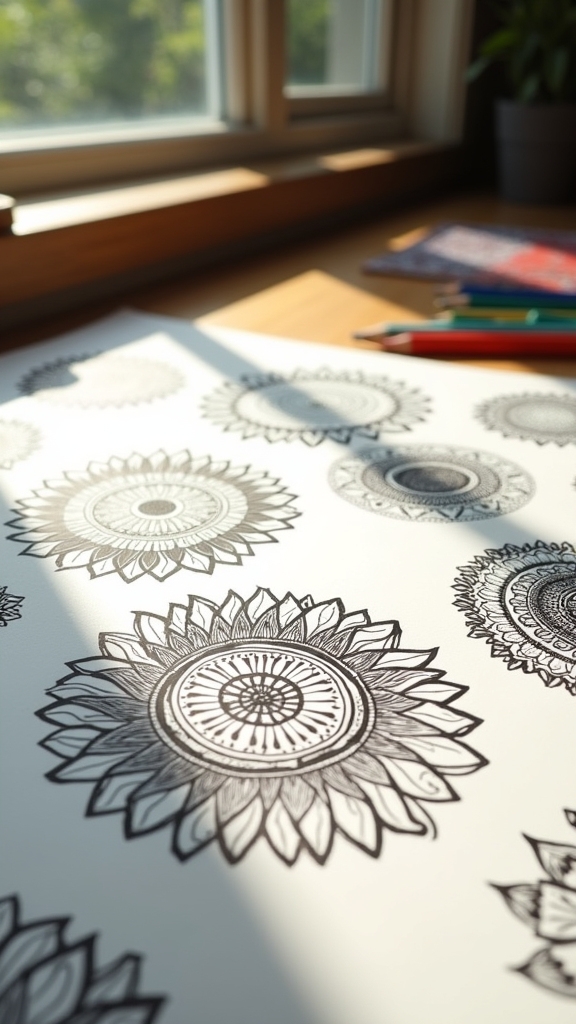
Freehand mandala sketches are a blast for anyone who loves to doodle and let their imagination run wild. With freehand techniques, artists aren’t tied down by rulers or stiff templates—just a pencil, some paper, and maybe a dash of courage!
Sketching tips for beginners include starting small, like drawing circles or petals, then slowly adding more shapes and patterns as confidence grows. The real mandala inspiration comes from experimenting with symmetry or even breaking the rules with a little asymmetry.
Adding dots, lines, and wild curves can totally level up the design, making each mandala unique. Plus, the process is super chill, almost like a meditation session, helping artists unwind and focus at the same time.
Mandalas Incorporating Gold Leaf Accents
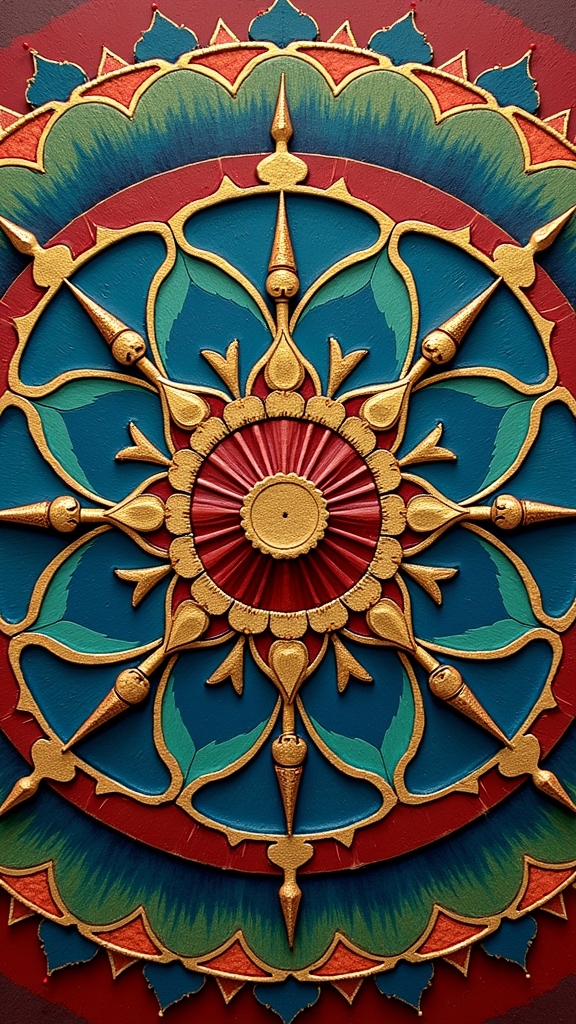
Gold leaf in mandala artwork is like adding a little bit of magic—suddenly, the design glows with a fancy, eye-catching shine.
Artists use gold leaf techniques to highlight special areas, making certain patterns pop and shimmer. Gilding mandala applications isn’t just about looking cool, though—it’s a way to bring elegance and drama to the piece.
The reflective design elements change with the light, so your mandala can look totally different depending on where you stand or the time of day. Imagine showing off your artwork and having everyone gasp as it catches the sunlight!
- Gold leaf accents make mandalas feel precious and unique.
- Reflective design elements create magical, ever-changing effects.
- Gilding mandala applications add that wow-factor everyone loves.
Collaborative Community Mandala Projects
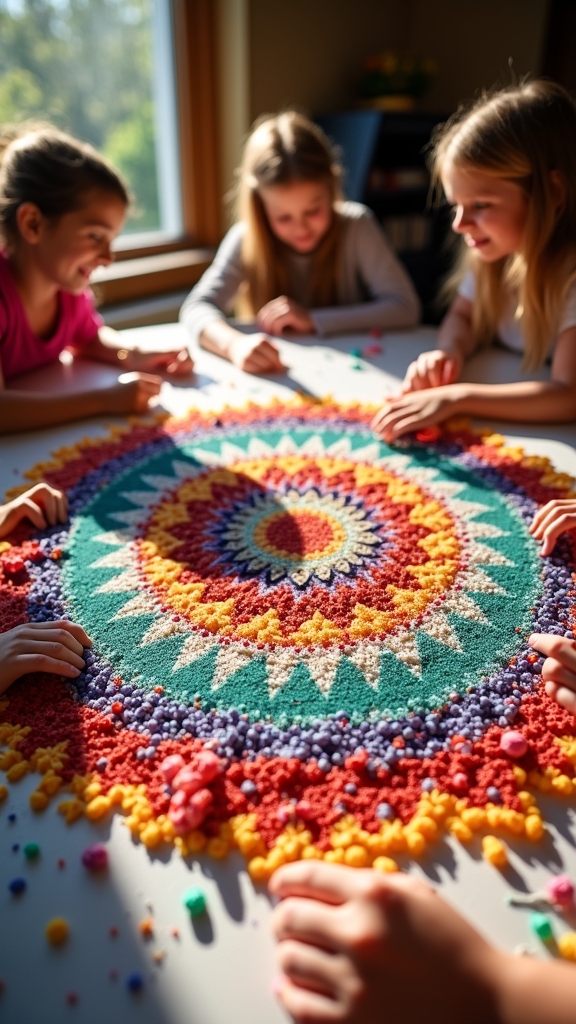
While some mandalas sparkle with fancy gold leaf, others shine because of the people who make them together.
Collaborative community mandala projects are all about teamwork, bringing neighbors, classmates, or even total strangers together to create something amazing. These giant mandalas often use natural stuff—like flowers, leaves, or stones—which makes the art eco-friendly and shows off sustainable art practices.
Community engagement strategies, like inviting everyone to share their ideas and designs, help boost collective creativity and make sure every voice gets heard.
Sometimes, the finished mandala becomes a cool public art piece, brightening up a park or schoolyard. Photos and social media posts let others see the process and maybe even try it themselves.
It’s art, togetherness, and a little bit of nature magic!
Frequently Asked Questions
What Is the Cultural Significance of Mandalas in Different Traditions?
Mandalas hold deep spiritual symbolism across cultures, representing unity and the universe. They serve as tools for meditation, artistic expression, and preserving cultural heritage, particularly in Hinduism, Buddhism, and Indigenous traditions, reflecting profound philosophical and spiritual meanings.
How Can I Protect and Preserve My Finished Mandala Artwork?
To protect and preserve finished mandala artwork, one should consider appropriate varnishing techniques for surface protection, use archival materials to prevent deterioration, and implement storage solutions such as acid-free folders or frames to minimize environmental damage and fading.
Are There Specific Apps for Easily Designing Digital Mandalas?
The current question addresses whether specific apps exist for designing digital mandalas. Various digital tools, such as iOrnament and Amaziograph, offer specialized app features and design techniques, enabling users to easily create intricate digital mandala patterns.
What Are Some Effective Ways to Frame and Display Mandala Art?
When considering Framing Techniques and Display Ideas for mandala art, individuals might choose shadow boxes, floating frames, or minimalist borders. Creative Arrangements could involve grouping several pieces, using circular mats, or incorporating mandalas into wall collages.
Can Mandala Creation Help With Stress Reduction and Mindfulness?
The practice of mandala creation is often associated with mindfulness meditation, offering individuals an opportunity for creative expression. Research suggests it can provide therapeutic benefits, such as stress reduction and enhanced focus, through its calming, repetitive patterns and intentional design.
Conclusion
Mandala art isn’t just about circles and patterns—it’s a creative adventure waiting to happen. With so many styles, from black and white classics to wild watercolor splashes, there’s something for everyone. Maybe you’ll doodle your own freehand masterpiece, or even rope in your friends for a giant community mandala. However you start, remember: there are no rules, just endless ways to express yourself. So grab your supplies, get messy, and let your imagination run wild!

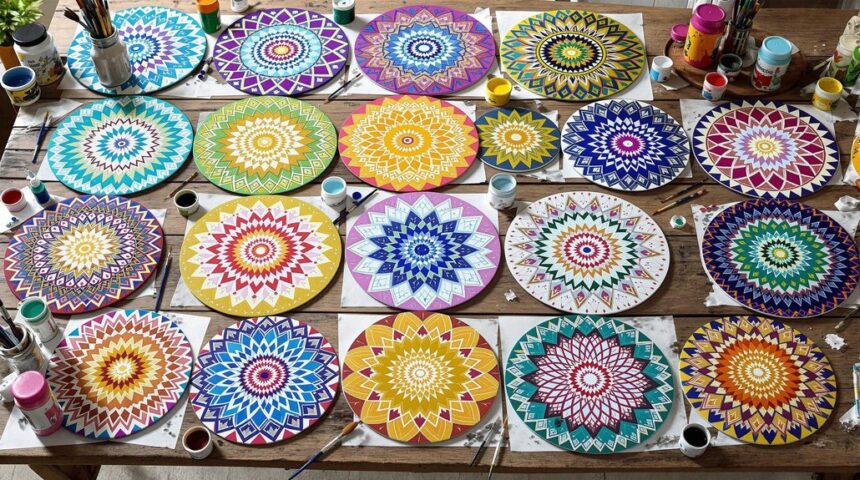
Leave a Reply